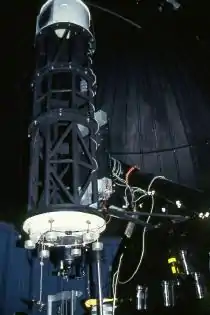Dark Sky Observatory
The Dark Sky Observatory (DSO) is an astronomical observatory owned and operated by Appalachian State University (ASU). It is located 9 kilometers (5.6 mi) east of Deep Gap, North Carolina (USA), off of the Blue Ridge Parkway, and 32 kilometers (20 mi) east of the ASU campus in Boone, North Carolina It was established in 1981, and is used for research, instruction, and public viewing events.[1] The Cline Visitors' Center was completed in 2011.[2]
| Organization | Appalachian State University | ||||||||
|---|---|---|---|---|---|---|---|---|---|
| Location | North Carolina | ||||||||
| Coordinates | 36.2514°N 81.4121°W | ||||||||
| Altitude | 932 meters (3,058 ft) | ||||||||
| Established | 1981 | ||||||||
| Website | Dark Sky Observatory | ||||||||
| Telescopes | |||||||||
| |||||||||
 Location of Dark Sky Observatory | |||||||||
Telescopes
- A 32 in (0.81 m) Ritchey–Chrétien telescope was built by DFM Engineering, as was the equatorial fork mount. It is the primary research tool at the observatory.[3]
 The 32-inch DFM Engineering telescope at Appalachian State University's Dark Sky Observatory.
The 32-inch DFM Engineering telescope at Appalachian State University's Dark Sky Observatory. - A 18 in (0.46 m) Cassegrain telescope on a German equatorial mount was installed in 1981. It is used to monitor eclipsing binary stars and was once used to observe Mira variable stars.[1][4]
 The 18-inch telescope at Appalachian State University's Dark Sky Observatory
The 18-inch telescope at Appalachian State University's Dark Sky Observatory - The 17 in (0.43 m) Dean Glace Telescope is a corrected Dall-Kirkham telescope made by Planewave and set on a Mathis equatorial fork mount. It is shared between ASU and astrophotographer Dean Glace, who donated the telescope.[5]
- A 14 in (0.36 m) C-14 Schmidt-Cassegrain Celestron reflector. The 14-inch remote robotic telescope, DSO-14, was assembled by Adam Smith for his Master's thesis project in 2009. It is automatically controlled by the Skynet Robotic Telescope Network in coordination with UNC-Chapel Hill. As well as offering queue-scheduled observing to both scientists and the general public, it is automatically commanded to observe the optical afterglows of Gamma-ray bursts within seconds of notification from the Swift Gamma-Ray Burst Mission.[6]
Former telescopes
- A 16 in (0.41 m) reflecting telescope built by DFM Engineering was originally located at the Rankin Science Center on the ASU campus in Boone. It was moved to DSO in 2003 while the building was being refurbished.[7] It was installed in the Rankin Science Observatory (RSO) on the roof of the building in 2005, where it is used for undergraduate instruction.[8]
- A 16 in (0.41 m) Newtonian telescope was donated to ASU in 1982, and was permanently mounted in its own dome in 1985. It was unused for several years before being removed in 2003.[1][9]
References
- "Observatory Reports: Appalachian State University". Bulletin of the American Astronomical Society. 18: 3. 1986. Bibcode:1986BAAS...18....3.
- "Dark Sky Observatory at Appalachian State University". Appalachian State University Department of Physics and Astronomy. Retrieved 2012-01-11.
- "Dark Sky Observatory 32-inch Telescope". Appalachian State University Department of Physics and Astronomy. Retrieved 2013-06-13.
- "Dark Sky Observatory 18-inch Telescope". Appalachian State University Department of Physics and Astronomy. Retrieved 2013-06-13.
- "Dark Sky Observatory Automatic Telescope". Appalachian State University Department of Physics and Astronomy. Retrieved 2013-06-13.
- "Dark Sky Observatory 14-inch Telescope". Appalachian State University Department of Physics and Astronomy. Retrieved 2013-06-13.
- "Dark Sky Observatory 16-inch telescope". Appalachian State University Department of Physics and Astronomy. Retrieved 2012-01-30.
- "Rankin Science Observatory (RSO) at Appalachian State University". Appalachian State University Department of Physics and Astronomy. Retrieved 2012-01-30.
- "Dark Sky Observatory 16-inch Newtonian". Appalachian State University Department of Physics and Astronomy. Archived from the original on 2003-03-14. Retrieved 2012-01-30.
External links
- Department of Physics and Astronomy at ASU
- ASU Dark Sky Observatory Clear Sky Chart Forecasts of observing conditions.
- Skynet Telescope Operations
This article is issued from Wikipedia. The text is licensed under Creative Commons - Attribution - Sharealike. Additional terms may apply for the media files.